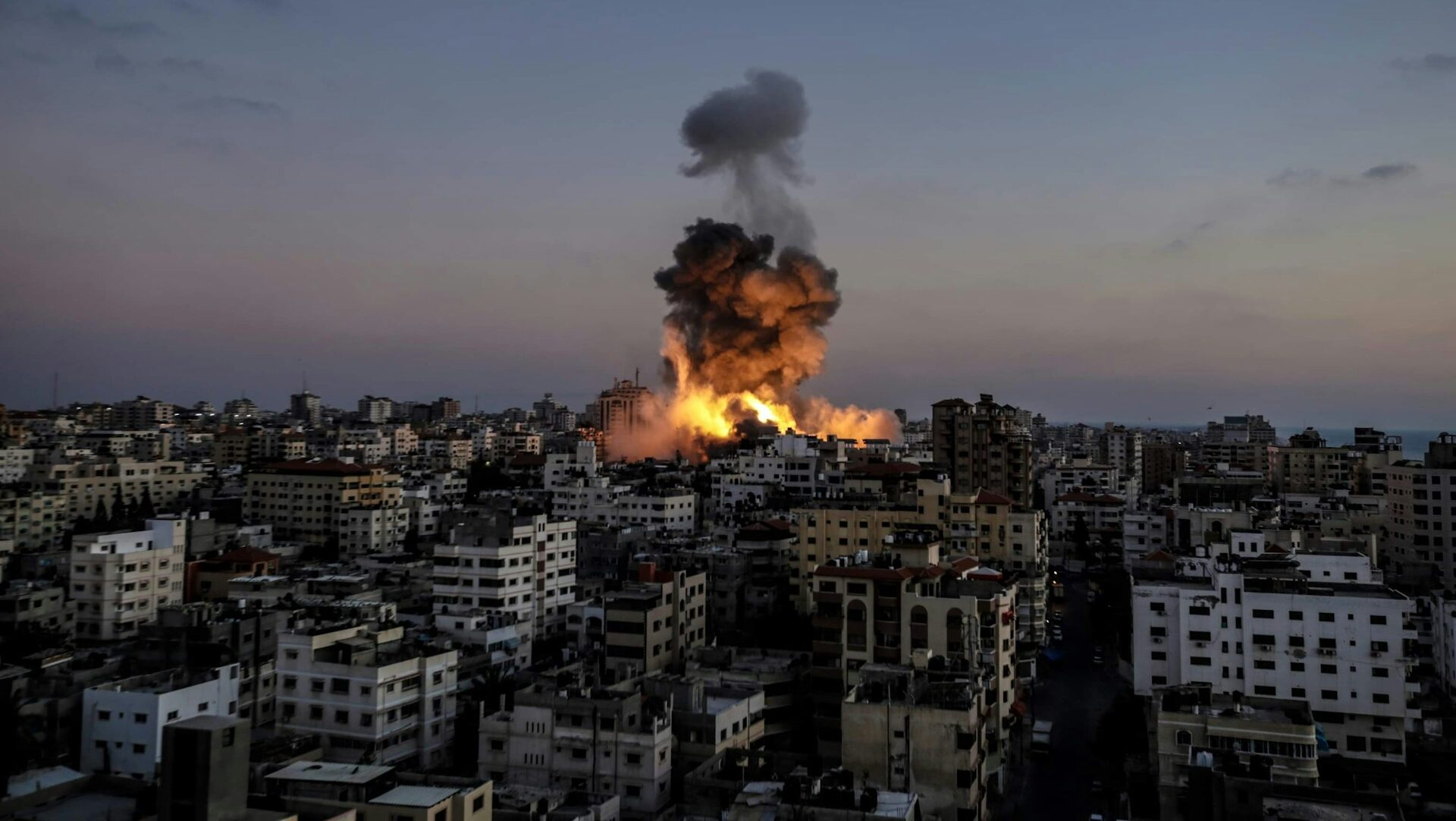As we witness the devastating humanitarian crisis unfolding in Gaza in 2025, with over 470,000 people facing starvation and entire communities displaced multiple times, the urgent need to understand the Israel Palestine conflict has never been more pressing. The current crisis, triggered by Hamas’s October 7, 2023 attack and Israel’s subsequent military response, represents the latest and most catastrophic chapter in a conflict that has spanned over a century. While recent geopolitical shifts, including the Abraham Accords and evolving US policies, have reshaped regional dynamics, the fundamental questions of sovereignty, security, and human rights that lie at the heart of this conflict remain unresolved. The enduring human cost of this dispute is impossible to ignore, as millions of lives hang in the balance while the international community grapples with finding sustainable solutions to one of the world’s most intractable conflicts.
The Israel Palestine conflict explained through decades of historical documentation reveals one of the most enduring and complex geopolitical disputes of the modern era. This comprehensive analysis examines the multifaceted dimensions of a conflict that has shaped Middle Eastern politics for over a century, affecting millions of lives and drawing international attention to fundamental questions of statehood, sovereignty, and human rights. Understanding the historical context of this dispute requires careful examination of competing narratives, examining both Israeli and Palestinian perspectives while maintaining analytical objectivity about the events that have unfolded since the early 20th century.
Table of contents
What is the Israel Palestine conflict?
The Israel Palestine conflict is a prolonged territorial and political dispute between Israelis and Palestinians over land, sovereignty, and national rights in the region historically known as Palestine. At its core, the conflict involves competing claims to the same territory, with both peoples asserting historical, religious, and political connections to the land between the Jordan River and the Mediterranean Sea. The dispute encompasses issues of borders, Jerusalem’s status, Palestinian refugees, Israeli security concerns, and the fundamental question of whether two separate states can coexist in this contested region.
Historical roots of the Israeli Palestinian conflict
Ancient claims and religious significance
The historical context of Gaza and the broader Palestinian territories extends back millennia, with the land holding profound significance for Judaism, Christianity, and Islam. Ancient historical claims to the region include those of the Israelites, who established kingdoms in the area around 1000 BCE, and various other peoples including the Philistines, from whom the name “Palestine” derives. These competing historical narratives form the foundation for modern territorial disputes, though historians emphasise that ancient claims alone cannot determine contemporary sovereignty.
The religious importance of Jerusalem and surrounding areas cannot be overstated, with the city containing sites sacred to all three Abrahamic faiths. For Jews, Jerusalem houses the Western Wall and the site of the ancient Temple; for Christians, it contains the Church of the Holy Sepulchre; and for Muslims, the Al-Aqsa Mosque and Dome of the Rock mark the third holiest site in Islam.
Why is Jerusalem so contested?
Jerusalem’s contested status stems from its simultaneous significance as a holy city for Judaism, Christianity, and Islam, combined with competing national claims by both Israelis and Palestinians. Israelis consider Jerusalem their “eternal and undivided capital,” while Palestinians claim East Jerusalem as the capital of their future state. The city’s religious sites, particularly the Temple Mount/Haram al-Sharif complex, remain flashpoints for tension as they hold sacred meaning for both Jewish and Muslim communities. International law considers East Jerusalem occupied Palestinian territory under the Fourth Geneva Convention, though Israel disputes this designation.
Ottoman rule and pre-Zionist demographics
Before the emergence of political Zionism in the late 19th century, Palestine formed part of the Ottoman Empire for over 400 years. The demographic composition of Ottoman Palestine included a majority Arab population, both Muslim and Christian, alongside smaller Jewish communities that had maintained continuous presence in the region. Ottoman records indicate that by the late 19th century, the population of Palestine was approximately 85% Arab and 15% Jewish, though exact figures remain disputed among historians.
The Ottoman administrative structure treated Palestine as part of the Damascus Vilayet initially, later reorganising it into separate administrative units. This period saw relatively stable coexistence among different religious communities, though economic conditions remained challenging for most inhabitants.
The rise of Zionism and Arab nationalism
Emergence of political Zionism
The roots of Israeli Palestinian conflict can be traced to the late 19th century emergence of political Zionism, a movement that sought to establish a Jewish homeland in Palestine. Theodor Herzl, often considered the father of modern Zionism, convened the First Zionist Congress in Basel in 1897, formally launching the movement for Jewish statehood. The Zionist movement emerged partly as a response to European antisemitism and pogroms, particularly in Eastern Europe.
Early Jewish immigration to Palestine, known as aliyah, began in the 1880s with the First Aliyah (1882-1903), followed by the Second Aliyah (1904-1914). These early settlers established agricultural communities and began purchasing land from Arab landowners, sometimes leading to displacement of Arab tenant farmers.
Development of Palestinian national identity
Parallel to the emergence of Zionism, Arab nationalism began developing throughout the Ottoman Empire in the late 19th and early 20th centuries. Palestinian national consciousness evolved gradually, initially as part of broader Arab nationalism but increasingly focusing on Palestinian-specific concerns as Jewish immigration increased. The development of Palestinian identity was influenced by encounters with Zionist settlement, British colonial policies, and the broader context of Arab independence movements.
Arab opposition to Zionist settlement manifested in various forms, from peaceful protests to violent confrontations, reflecting growing concerns about land sales, demographic changes, and political implications of increased Jewish immigration.
The British Mandate period and the Balfour Declaration
The Balfour Declaration’s impact
The history of Israel Palestine conflict took a decisive turn with the Balfour Declaration of November 2, 1917, in which Britain declared support for “the establishment in Palestine of a national home for the Jewish people”. This declaration, issued during World War I, represented the first major international endorsement of Zionist aspirations. However, the declaration also stated that “nothing shall be done which may prejudice the civil and religious rights of existing non-Jewish communities in Palestine,” creating an inherent tension that would define subsequent decades.
The declaration’s language was deliberately ambiguous, referring to a “national home” rather than a “state,” and failing to specify geographical boundaries or the political status of the proposed homeland. This ambiguity later contributed to conflicting interpretations and expectations among Jews, Arabs, and British officials.
British mandate administration
Following the end of World War I and the collapse of the Ottoman Empire, the League of Nations granted Britain the Mandate for Palestine in 1920, formally beginning the British Mandate period that lasted until 1948. The Mandate incorporated the Balfour Declaration’s principles, committing Britain to facilitate Jewish immigration and settlement while protecting the rights of existing communities.
British administration faced mounting challenges as Jewish immigration increased substantially, particularly during the 1930s as Jews fled Nazi persecution in Europe. The Jewish population of Palestine grew from approximately 85,000 in 1922 to over 400,000 by 1936, fundamentally altering the demographic balance. This rapid change intensified Arab opposition and led to increasing intercommunal violence.
Arab revolts and British responses
Growing tensions culminated in several major Arab uprisings, including the 1929 Hebron Massacre, where Arab riots resulted in the deaths of 67 Jews. The most significant uprising was the Arab Revolt of 1936-1939, a sustained Palestinian rebellion against British rule and continued Jewish immigration. The revolt began as a general strike but evolved into guerrilla warfare that required substantial British military intervention to suppress.
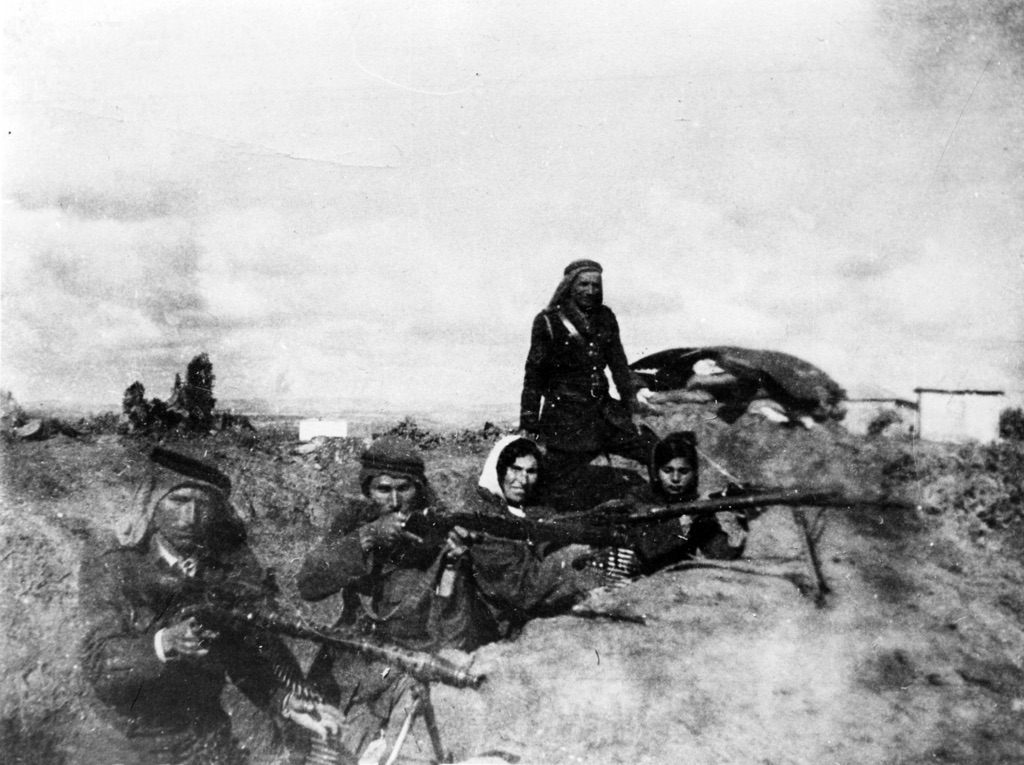
British responses to Arab concerns included various White Papers attempting to limit Jewish immigration and land purchases. The White Paper of 1939 severely restricted Jewish immigration at the very moment when European Jews faced the greatest persecution, creating profound tensions with the Jewish community in Palestine.
The 1948 war: independence and Nakba
UN partition plan and its rejection
The Palestine Israel conflict timeline reached a critical juncture in November 1947 when the UN General Assembly passed Resolution 181, proposing the partition of Palestine into separate Jewish and Arab states. The plan allocated approximately 56% of Mandate Palestine to the proposed Jewish state, despite Jews comprising about one-third of the population. The Jewish leadership accepted the partition plan, while Arab states and Palestinian leaders rejected it, arguing it was unfair and violated the UN Charter.
The partition plan triggered immediate violence between Jewish and Arab communities, marking the beginning of what would become the 1948 Arab-Israeli War. British forces began withdrawing from Palestine as the Mandate approached its end, creating a power vacuum that both sides sought to fill.
Declaration of independence and war
On May 14, 1948, David Ben-Gurion proclaimed the establishment of the State of Israel, immediately recognised by the United States and Soviet Union. The following day, armies from Egypt, Jordan, Syria, Lebanon, and Iraq invaded the newly declared state, beginning the first Arab-Israeli war. The conflict lasted until early 1949, resulting in Israeli victory and significant territorial gains beyond the UN partition boundaries.
The war’s outcome established Israel’s borders along the “Green Line” defined by the 1949 Armistice Agreements, which remained largely unchanged until the 1967 Six-Day War. Israel controlled approximately 78% of Mandate Palestine, while Jordan occupied the West Bank and Egypt controlled Gaza.
The palestinian Nakba
For Palestinians, the 1948 war represented the Nakba (“catastrophe”), involving the displacement of approximately 750,000 Palestinians from their homes. This displacement occurred through various means, including military operations, psychological warfare, and voluntary flight driven by fear and confusion. Palestinian refugees fled to neighbouring Arab countries, where many remain in refugee camps today.
The creation of the Palestinian refugee problem has remained a central issue in the conflict, with Palestinians asserting a right of return based on UN General Assembly Resolution 194. Israel has consistently opposed large-scale refugee return, citing security concerns and demographic implications.
How did the Six-Day War change everything?
The 1967 Six-Day War fundamentally transformed the Israel Palestine conflict by bringing the West Bank, Gaza Strip, East Jerusalem, and Golan Heights under Israeli military occupation. This war tripled the territory under Israeli control and brought over one million Palestinians under military occupation, creating the current reality of occupied territories that remains central to the conflict today. The war established Israel as the region’s dominant military power while simultaneously creating new obligations under international law as an occupying force.
Outbreak and military campaign
Growing tensions in 1967 led to the Six-Day War, fundamentally altering the Middle East conflict landscape. Egyptian President Nasser’s closure of the Straits of Tiran to Israeli shipping and the withdrawal of UN peacekeeping forces created a crisis that Israel viewed as an existential threat. On June 5, 1967, Israel launched preemptive air strikes that destroyed most of the Egyptian air force within hours.
Over six days, Israeli forces occupied the West Bank, Gaza Strip, Sinai Peninsula, and Golan Heights, tripling the territory under Israeli control. This victory brought over one million Palestinians under Israeli military occupation. The war’s speed and decisiveness shocked the Arab world and established Israel as the region’s dominant military power.
UN Resolution 242 and international response
In November 1967, the UN Security Council unanimously passed Resolution 242, calling for “withdrawal of Israeli armed forces from territories occupied in the recent conflict” and establishing the “land for peace” principle. The resolution’s deliberately ambiguous language regarding whether Israel must withdraw from all territories has contributed to decades of diplomatic disputes.
Resolution 242 became the foundation for subsequent peace negotiations, though its interpretation remains contentious. Palestinians initially rejected the resolution because it referred to them only as refugees rather than recognising their national rights.
Settlement movement and occupation
The Six Day War summary reveals how Israel’s occupation of Palestinian territories led to the establishment of Jewish settlements in violation of international law. The settlement movement began gradually but accelerated over subsequent decades, with approximately 700,000 Israeli settlers now living in the West Bank and East Jerusalem. The International Court of Justice and various UN bodies have consistently declared these settlements illegal under the Fourth Geneva Convention.
Settlement expansion has fragmented Palestinian territories and complicated prospects for a viable Palestinian state. The settlement enterprise represents one of the core obstacles to conflict resolution, as it creates facts on the ground that are difficult to reverse.
Peace efforts and continuing conflicts
The Yom Kippur War and Camp David Accords
The 1973 Yom Kippur War marked another crucial turning point in understanding the Middle East conflict. Egypt and Syria launched surprise attacks on the Jewish holy day of Yom Kippur, initially achieving tactical success before Israeli forces reversed their gains. The war’s aftermath led to Egyptian President Anwar Sadat’s historic peace initiative.
The Camp David Accords of 1978, mediated by US President Jimmy Carter, resulted in the first Arab-Israeli peace treaty. Egypt recognised Israel and regained the Sinai Peninsula, while Israel withdrew from Egyptian territory. However, the accords’ provisions for Palestinian autonomy were never fully implemented.
Lebanon war and PLO displacement
Israel’s 1982 invasion of Lebanon aimed to destroy PLO infrastructure and remove Palestinian forces from Israel’s northern border. The war resulted in PLO evacuation from Beirut but also led to Israel’s prolonged occupation of southern Lebanon. The conflict demonstrated the regional dimensions of the Palestine question and the difficulties of military solutions.
The Oslo Accords era
Historic breakthrough and mutual recognition
The Oslo Accords explained as a historic breakthrough emerged from secret negotiations between Israeli and PLO representatives in Norway. The September 1993 signing ceremony on the White House lawn, featuring the iconic handshake between Israeli Prime Minister Yitzhak Rabin and PLO Chairman Yasser Arafat, symbolised hopes for peace.
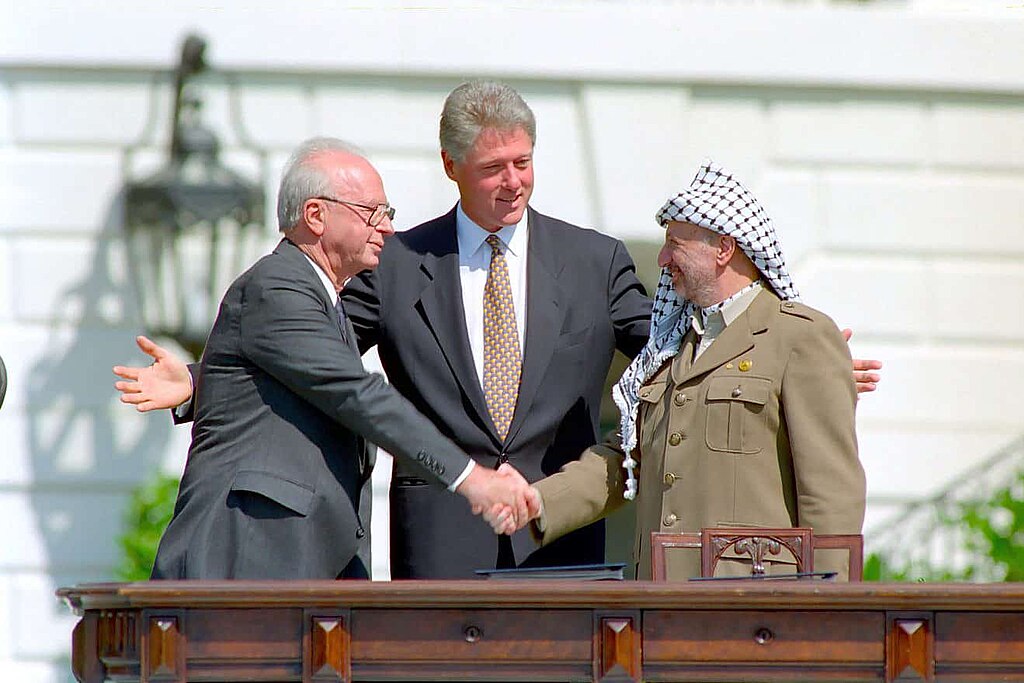
The Declaration of Principles established mutual recognition between Israel and the PLO and created a framework for Palestinian interim self-government. The Palestinian Authority was established to govern Palestinian populations in parts of the West Bank and Gaza. The accords envisioned a five-year interim period leading to final status negotiations on core issues.
Challenges and limitations
Despite initial optimism, the Oslo process faced substantial challenges that ultimately led to its collapse. Settlement construction continued during the interim period, doubling the settler population. Palestinian expectations for statehood were frustrated by Israeli security restrictions and limited territorial control.
The assassination of Yitzhak Rabin by a Jewish extremist in November 1995 dealt a severe blow to the peace process. Subsequent Israeli governments showed less commitment to the Oslo framework, while Palestinian groups like Hamas opposed the accords entirely.
The Second Intifada and its aftermath
Al-Aqsa Intifada eruption
The Second Intifada explained as the Al-Aqsa Intifada began in September 2000 following Ariel Sharon’s controversial visit to the Temple Mount/Haram al-Sharif. While the visit sparked immediate protests, deeper causes included Palestinian frustration with the failed peace process and continued settlement expansion.
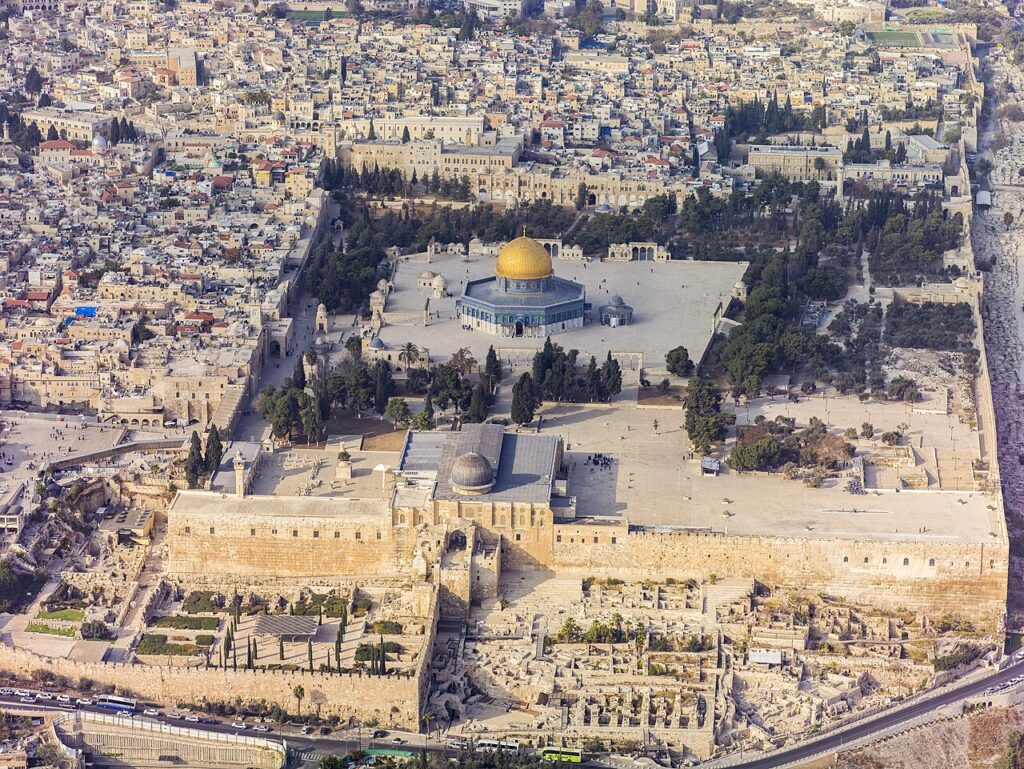
The uprising differed significantly from the First Intifada, featuring more organised violence, suicide bombings against Israeli civilians, and harsh Israeli military responses. The violence continued for five years, resulting in thousands of casualties on both sides and severely damaging Israeli-Palestinian relations.
Construction of the separation barrier
In response to suicide bombings, Israel began constructing a separation barrier in 2002, officially termed a security fence but criticised by Palestinians as an “apartheid wall”. The International Court of Justice ruled in 2004 that the barrier’s route through occupied territory violated international law. While Israel claims the barrier reduced terrorist attacks, Palestinians argue it creates a prison-like environment and separates families and communities.
Gaza Disengagement and Hamas ascendancy
Israeli withdrawal from Gaza
Israel’s 2005 Gaza Disengagement Plan involved the unilateral withdrawal of all Israeli settlements and military forces from the Gaza Strip. Prime Minister Ariel Sharon presented the disengagement as necessary for Israel’s security and demographic concerns. The withdrawal was completed in August 2005, ending 38 years of Israeli occupation of Gaza.
However, Israel maintained control over Gaza’s borders, airspace, and maritime access, leading to debates about whether the occupation truly ended. The disengagement did not include negotiations with Palestinians and was implemented unilaterally.
Hamas electoral victory and takeover
Palestinian legislative elections in January 2006 resulted in a surprising victory for Hamas, which defeated the ruling Fatah party. The international community, led by the United States and European Union, imposed sanctions on the Palestinian Authority, demanding that Hamas recognise Israel, renounce violence, and accept previous agreements.
Growing tensions between Hamas and Fatah culminated in June 2007 when Hamas seized complete control of Gaza in what some termed a civil war. This division effectively split Palestinian territories, with Hamas governing Gaza and the Palestinian Authority controlling parts of the West Bank.
Gaza blockade and humanitarian impact
Following Hamas’s takeover, Israel and Egypt imposed a blockade on Gaza, severely restricting the movement of people and goods. Israel justified the blockade as necessary to prevent weapons smuggling and terrorist attacks. However, humanitarian organisations have criticised the blockade’s impact on Gaza’s civilian population.
The blockade has contributed to Gaza’s economic collapse, with unemployment rates exceeding 40% and most of the population dependent on international aid. The territory’s infrastructure has deteriorated due to restrictions on construction materials and fuel.
The October 7 crisis and current humanitarian emergency
What happened on October 7, 2023?
On October 7, 2023, Hamas launched an unprecedented surprise attack on Israel, killing over 1,200 Israelis, taking 252 hostages, and sparking the current Gaza war. The attack involved thousands of Hamas fighters breaching Gaza’s security fence and conducting coordinated assaults on Israeli towns, military bases, and a music festival. The scale and brutality of the attack, including documented cases of sexual violence and targeting of civilians, marked the deadliest day for Jews since the Holocaust.
Israel’s response, dubbed “Operation Iron Sword,” involved massive aerial bombardments followed by a ground invasion of Gaza. The war has resulted in unprecedented destruction and civilian casualties, with over 53,000 Palestinians killed according to Gaza health authorities, including approximately 16,500 children. The conflict has displaced nearly Gaza’s entire population of 2.3 million people, often multiple times.
| Statistic | Number | Source period |
|---|---|---|
| Palestinian deaths in Gaza | 53655 | Oct 2023 – May 2025 |
| Children among casualties | 16500 | Oct 2023 – Sep 2024 |
| Displaced population | 2000000 | Current |
| Healthcare facilities dstroyed | 32 | Oct 2023 – May 2025 |
| Schools damaged/destroyed | 625 | Oct 2023 – May 2025 |
| People facing starvation | 470000 | May 2025 |
| Aid trucks needed daily (pre-war) | 500 | Before Oct 2023 |
| Aid trucks entering daily (current) | 30 | May 2025 |
| Israeli casualties (Oct 7) | 1200 | October 7, 2023 |
| Hostages taken | 252 | October 7, 2023 |
Current humanitarian crisis in Gaza
The ongoing humanitarian situation in Gaza represents one of the world’s worst crises in 2025, with 470,000 people facing starvation—representing 22% of the population. The collapse of Gaza’s healthcare system, with over 32 healthcare facilities destroyed, has left tens of thousands without access to medical care. The destruction extends to civilian infrastructure, with 625 schools damaged or destroyed and entire neighbourhoods reduced to rubble.
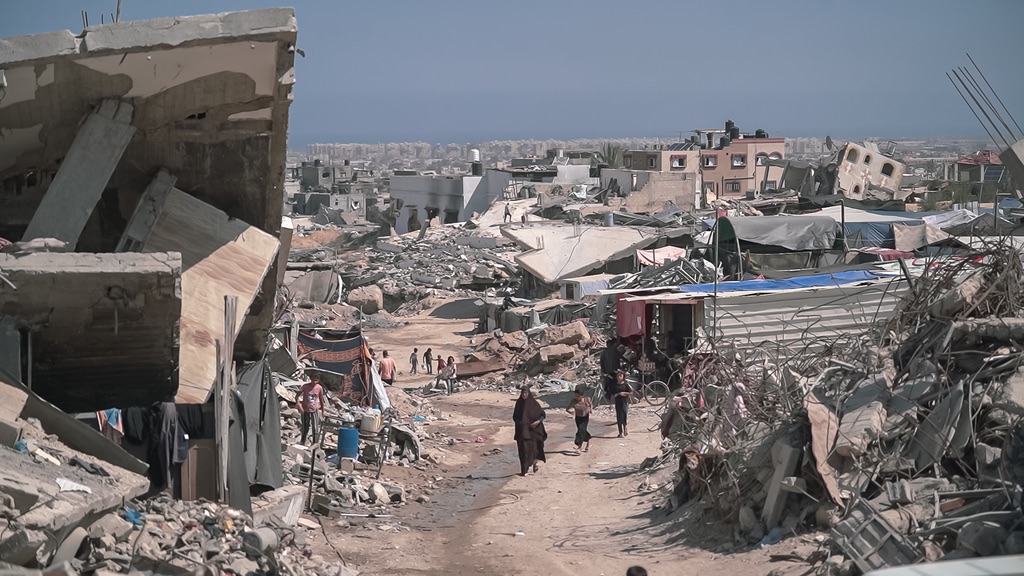
The humanitarian response has been severely hampered by Israel’s restrictions on aid delivery, with only 30 trucks entering Gaza daily compared to the 500 needed before the war. Between March and May 2025, a complete blockade prevented any humanitarian aid from entering Gaza for 11 weeks, exacerbating the crisis. UN agencies describe the situation as “apocalyptic,” with the entire population of northern Gaza at imminent risk of death from disease, famine, and violence.
International legal responses
The International Criminal Court issued historic arrest warrants in November 2024 for Israeli Prime Minister Benjamin Netanyahu and former Defense Minister Yoav Gallant, charging them with war crimes and crimes against humanity. The ICC also issued a warrant for Hamas military commander Mohammed Deif for the October 7 attacks. These warrants represent unprecedented international legal action against sitting Israeli leaders.
The International Court of Justice is reviewing a case accusing Israel of genocide in Gaza, while various UN experts and human rights organisations have documented systematic violations of international humanitarian law. The legal proceedings have isolated Israel diplomatically, with many countries expressing support for international accountability mechanisms.
Recent developments and regional changes
Trump administration policies and diplomatic shifts
The Trump administration’s policies significantly altered the traditional US approach to the Israel Palestine conflict explained through decades of diplomatic precedent. In December 2017, President Trump recognised Jerusalem as Israel’s capital and moved the US embassy there from Tel Aviv. This decision broke with decades of international consensus that Jerusalem’s status should be determined through negotiations.
However, recent developments show evolving US approaches to the crisis, with the Trump administration in 2025 expressing frustration with Israel’s conduct of the war and seeking new ceasefire initiatives. The administration has engaged directly with Hamas through intermediaries, representing a shift from traditional diplomatic channels. These efforts reflect growing US concerns about the humanitarian catastrophe and its regional implications.
The Abraham Accords after Gaza
The Abraham Accords represent a significant shift in regional dynamics, as several Arab states normalised relations with Israel without resolving the Palestinian issue. The United Arab Emirates and Bahrain signed normalisation agreements in September 2020, followed by Morocco and Sudan. These agreements broke the long-standing Arab consensus that normalisation should follow Palestinian independence.
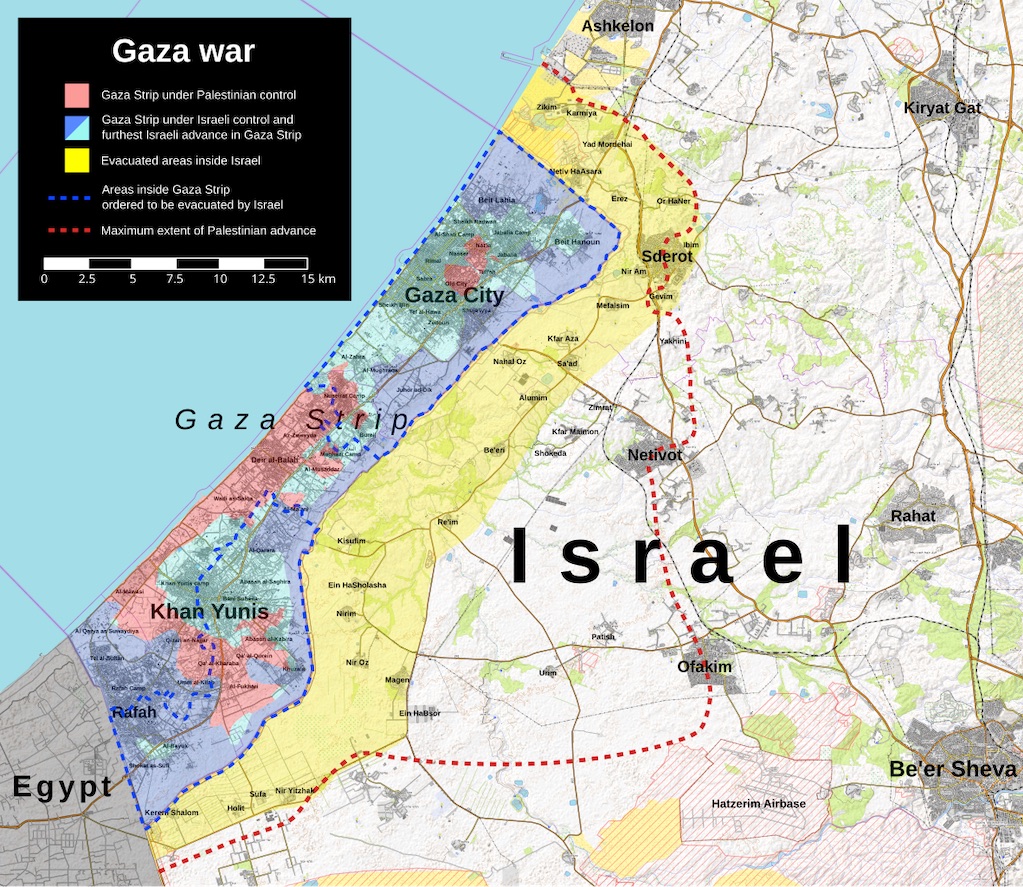
The accords have shown remarkable resilience despite the Gaza war, with diplomatic and economic ties largely surviving the crisis. However, the ongoing violence has complicated expansion efforts, particularly regarding Saudi Arabia, which had been considered the most significant potential addition to the accords. Recent Trump administration statements suggest renewed optimism about expanding the accords, with officials hinting at potential breakthroughs by 2026.
The agreements continue to provide economic and strategic benefits to signatory countries, including enhanced security cooperation and technological partnerships. However, critics argue they have marginalised Palestinian concerns and reduced incentives for Israeli concessions on Palestinian statehood.
What are the core issues in the Israel Palestine conflict today?
The main issues in the Israeli-Palestinian conflict encompass eight fundamental areas where Israeli and Palestinian positions remain fundamentally opposed, despite decades of negotiations. These core issues—borders, Jerusalem, refugees, security, settlements, water resources, Gaza’s status, and mutual recognition—form the heart of any potential resolution and reflect the conflict’s complexity. Understanding these positions is crucial for comprehending why peace negotiations have repeatedly failed and what compromises might be necessary for future agreements.
| Core issue | Israeli position | Palestinian position | International law |
|---|---|---|---|
| Borders & territory | Secure borders with major settlement blocs retained | 1967 borders with minimal land swaps | 1967 borders as basis for negotiations |
| Jerusalem status | Undivided capital of Israel | East Jerusalem as Palestinian capital | East Jerusalem part of occupied territory |
| Palestinian refugees | No mass return; compensation preferred | Right of return based on UN Resolution 194 | Right of return; voluntary repatriation/compensation |
| Israeli security | Military presence in Jordan Valley; demilitarized Palestinian state | End occupation; international guarantees | Proportionate security measures only |
| Settlement activity | Natural growth in existing settlements | Complete settlement removal from West Bank | Settlements illegal under Fourth Geneva Convention |
| Water resources | Continued access to West Bank aquifers | Equitable sharing of water resources | Equitable sharing of transboundary waters |
| Gaza blockade | Necessary for security until Hamas disarmed | Complete lifting of blockade | Collective punishment prohibited |
| Recognition & legitimacy | Jewish state recognition required | Palestinian state recognition; end occupation | Right to self-determination for both peoples |
Borders and territory
The question of borders remains central to any resolution of the Israel Palestine conflict explained through competing territorial claims. Palestinians seek a state based on the 1967 borders, encompassing the West Bank, Gaza Strip, and East Jerusalem. Israel argues that the 1967 lines are indefensible and seeks to retain major settlement blocs through land swaps.
The expansion of Israeli settlements has fundamentally altered the territorial landscape, making the creation of a contiguous Palestinian state increasingly difficult. Some analysts argue that the “two-state solution” is no longer viable due to settlement expansion.
The Jerusalem question
Why is there conflict between Israel and Palestine often centres on competing claims to Jerusalem, which both peoples consider their capital. Israel has declared Jerusalem its “eternal and undivided capital,” while Palestinians claim East Jerusalem as the capital of their future state. The city’s religious significance to Judaism, Christianity, and Islam adds emotional intensity to political disputes.
International law and UN resolutions consider East Jerusalem occupied Palestinian territory, but Israel disputes this designation. The status of Jerusalem’s holy sites remains particularly sensitive, with the current “status quo” arrangements governing access and worship.
Palestinian refugees and right of return
The Palestinian refugee crisis history spans over seven decades, with approximately 5.9 million Palestinians registered as refugees with UNRWA. Palestinians assert a “right of return” based on UN Resolution 194 and international law. Most Israeli Jews oppose large-scale refugee return, arguing it would fundamentally alter Israel’s demographic composition and Jewish character.
Proposed solutions include compensation, resettlement in a Palestinian state, or limited family reunification, but no consensus exists. The refugee issue represents both a humanitarian crisis and a political obstacle to peace.
Security concerns
Israeli security concerns stem from historical experiences of violence and the strategic vulnerability of a small state surrounded by larger neighbours. Palestinians argue that their security requires ending the occupation and achieving statehood. Different perceptions of security threats and requirements reflect the conflict’s asymmetrical nature.
The October 7 attack has intensified Israeli security concerns, while the massive civilian casualties in Gaza have highlighted Palestinian vulnerability. Both communities now face trauma that will influence future security arrangements.
International law and diplomatic efforts
UN resolutions and international consensus
The role of international law in the Israel Palestine conflict centres on numerous UN resolutions addressing occupation, settlements, and refugee rights. Key resolutions include UN Resolution 242’s land-for-peace formula, Resolution 338’s ceasefire terms, and Resolution 194’s refugee provisions. However, enforcement mechanisms remain weak, and different interpretations of these resolutions persist.
The International Court of Justice has issued advisory opinions declaring Israeli settlements illegal and the separation barrier unlawful. While not legally binding, these opinions reflect international legal consensus. Recent UN General Assembly resolutions continue to emphasise that a two-state solution remains the “only path to lasting peace” in the region.
Regional and international actors
Various international actors have attempted to mediate the conflict, including the United States, United Nations, European Union, and Russia as part of the Middle East Quartet. The US has traditionally played the dominant mediation role, though its perceived bias toward Israel has limited its effectiveness.
Regional actors including Egypt, Jordan, and Saudi Arabia have also played important roles, particularly in peace initiatives and refugee assistance. The Arab Peace Initiative of 2002 offered comprehensive normalisation in exchange for Israeli withdrawal to 1967 borders. Recent Arab summits have shown renewed diplomatic coordination, with countries collectively rejecting plans for Palestinian displacement while supporting ceasefire efforts.
Current ceasefire efforts and peace prospects
Why have ceasefire negotiations failed?
Ceasefire negotiations between Israel and Hamas have repeatedly failed due to fundamental disagreements about the conflict’s end goals. Israel insists on temporary pauses to facilitate hostage releases while maintaining its objective to dismantle Hamas entirely. Hamas demands a permanent ceasefire, complete Israeli withdrawal from Gaza, and the release of thousands of Palestinian prisoners.
The latest US ceasefire proposal in May 2025 has faced similar obstacles, with Hamas rejecting it as failing to meet Palestinian demands for ending hostilities. Israeli officials have accepted the proposal, but critics suggest this may be a strategic move to place blame on Hamas for continued fighting. The 58 remaining hostages in Gaza represent Hamas’s primary leverage, while Israel’s military campaign continues despite international pressure.
International mediation efforts
Current mediation efforts involve the United States, Egypt, and Qatar working to broker agreements between the parties. The Trump administration has established direct communication channels with Hamas through intermediaries, representing a departure from traditional diplomatic protocols. However, the effectiveness of these channels remains questionable given the limited experience of mediators and the geographical separation of Hamas decision-makers.
Recent proposals include 60-day temporary ceasefires, prisoner exchanges, and increased humanitarian aid, but they fall short of addressing core political issues. The cyclical nature of violence and failed negotiations highlights the need for more comprehensive approaches that address root causes rather than just immediate crises.
Challenges to peace and future prospects
What makes the two-state solution so difficult?
The two state solution explained as the international consensus for resolving the conflict faces increasing scepticism due to settlement expansion and political realities. Israeli settlements now house approximately 700,000 people in the West Bank and East Jerusalem, creating physical and political obstacles to Palestinian statehood. The fragmentation of Palestinian territories and settler road networks have made a contiguous Palestinian state increasingly difficult to achieve.
Internal Palestinian divisions between Hamas and Fatah have prevented unified Palestinian negotiating positions. Israeli domestic politics have also shifted rightward, with less support for territorial concessions. These realities have led some analysts to argue that a one-state reality already exists, with Israel controlling all territory between the Jordan River and Mediterranean Sea.
Alternative solutions and their challenges
Proposed alternatives include confederation models, federal arrangements, or managed autonomy, but none command broad support. The demographic implications of any arrangement remain controversial, with both peoples seeking to maintain their national character. Plans for Palestinian displacement, briefly discussed by some Trump administration officials, have been firmly rejected by Arab states and the international community.
The current crisis has highlighted the urgency of finding sustainable solutions while demonstrating the limitations of military approaches. Religious and political extremism on both sides continues to undermine moderate voices and peace constituencies.
Understanding and moving forward
The Israel Palestine conflict explained through comprehensive historical analysis reveals the complexity of competing claims, narratives, and grievances that have accumulated over more than a century. Both Israelis and Palestinians have legitimate aspirations for security, dignity, and self-determination that must be acknowledged in any sustainable resolution. The human cost of this conflict, measured in decades of suffering, displacement, and lost opportunities for cooperation, underscores the urgent need for creative solutions.
Moving forward requires understanding that historical grievances, while important for context, cannot alone determine future arrangements. The challenge lies in balancing historical justice with practical possibilities, considering demographic realities, security requirements, and international law. Education, dialogue, and leadership committed to peace remain essential ingredients for any eventual resolution.
The international community’s role remains crucial, particularly in supporting economic development, humanitarian assistance, and confidence-building measures. However, sustainable peace ultimately depends on the willingness of Israelis and Palestinians themselves to make difficult compromises and accept shared responsibility for their common future.
This analysis has attempted to present the historical record objectively, acknowledging the complexity and sensitivity of issues that affect millions of people. Readers are encouraged to engage with diverse perspectives, consult primary sources, and approach this subject with the nuance and empathy it demands. Only through informed understanding can constructive dialogue emerge about one of the world’s most challenging conflicts.
The current humanitarian emergency in Gaza serves as a stark reminder that the cost of inaction extends far beyond political calculations—it is measured in human lives, childhood dreams cut short, and communities torn apart. As we witness unprecedented suffering unfold in real-time, the moral imperative for peace has never been clearer. The path forward may seem impossibly complex, but history shows us that even the most entrenched conflicts can find resolution when humanity, justice, and hope prevail over fear and hatred.
Israel-Palestine conflict key events timeline
Major historical milestones (1917-2023)
Early period (1917-1948)
- 1917 – Balfour Declaration: Britain declares support for Jewish national home in Palestine
- 1920 – British Mandate begins: League of Nations grants Britain mandate over Palestine
- 1929 – Hebron Massacre: Arab riots kill 67 Jews in Hebron
- 1936-1939 – Arab Revolt: Three-year Palestinian uprising against British rule and Jewish immigration
- 1947 – UN Partition Plan: UN Resolution 181 proposes partition of Palestine
Foundation period (1948-1967)
- 1948 – Israel declares independence & Nakba: State established, 750,000+ Palestinians displaced
- 1949 – Armistice Agreements: End of 1948 Arab-Israeli War, Green Line established
- 1956 – Suez Crisis: Israel invades Sinai Peninsula with Britain and France
- 1964 – PLO founded: Palestine Liberation Organization established
Occupation period (1967-1987)
- 1967 – Six-Day War: Israel occupies West Bank, Gaza Strip, Sinai, and Golan Heights
- 1967 – UN Resolution 242: Calls for withdrawal from occupied territories and lasting peace
- 1973 – Yom Kippur War: Egypt and Syria launch surprise attack on Israel
- 1978 – Camp David Accords: Egypt-Israel peace agreement signed
- 1982 – Lebanon War: Israel invades Lebanon, PLO expelled from Beirut
Resistance period (1987-2000)
- 1987 – First Intifada begins: Palestinian uprising in occupied territories
- 1987 – Hamas founded: Islamic Resistance Movement established in Gaza
- 1993 – Oslo Accords signed: Israel-PLO mutual recognition and interim self-government
- 1995 – Rabin assassinated: Israeli Prime Minister killed by Jewish extremist
Modern period (2000-Present)
- 2000 – Camp David Summit fails: Final status negotiations collapse
- 2000 – Second Intifada begins: Al-Aqsa Intifada erupts after Sharon’s Temple Mount visit
- 2002 – West Bank barrier: Israel begins construction of separation wall
- 2005 – Gaza Disengagement: Israel withdraws settlements and military from Gaza
- 2006 – Hamas wins elections: Hamas defeats Fatah in Palestinian legislative elections
- 2007 – Hamas takeover: Hamas seizes control of Gaza from Fatah
- 2008-2021 – Gaza Wars: Multiple military operations (Cast Lead, Pillar of Defense, Protective Edge, Guardian of Walls)
- 2017 – Trump recognizes Jerusalem: US moves embassy to Jerusalem, recognizes as Israeli capital
- 2020 – Abraham Accords: UAE and Bahrain normalize relations with Israel
- 2023 – October 7 & Gaza War: Hamas attack kills 1,200+, Israel launches massive retaliation
Key statistics
Demographics
- Palestinian population worldwide: ~14 million
- Palestinian refugees registered with UNRWA: ~5.9 million
- Gaza population density: ~5,200 people/km² (among world’s highest)
- Israeli settlers in West Bank/East Jerusalem: ~700,000
Territory
- Historic Palestine total area: ~27,000 km²
- Israel (pre-1967 borders): ~20,770 km²
- West Bank: ~5,860 km²
- Gaza Strip: ~365 km²
Core issues
- Borders: 1967 lines vs. current territorial control
- Jerusalem: Competing capital claims
- Refugees: Right of return vs. demographic balance
- Security: Israeli security needs vs. Palestinian sovereignty
- Settlements: International law violations vs. Israeli claims

